Maine forms the northeastern corner of the United States. West Quoddy Head, a small peninsula of Maine, is the country’s easternmost piece of land. The nearby town of Eastport lies farther east than any other U.S. town or city. On a map, northern Maine looks like a giant wedge between the Canadian provinces of New Brunswick and Quebec. Augusta is the capital of Maine, and Portland is the largest city.
Maine, the largest of the New England States in area, is probably best known for its beautiful shore on the Atlantic Ocean. Along this famous “rock-bound” coast of the state are lighthouses, sandy beaches, quiet fishing villages, thousands of offshore islands, and Acadia National Park—the only national park in New England. Jagged rocks and cliffs and thousands of bays and inlets add to the rugged beauty of Maine’s coast.
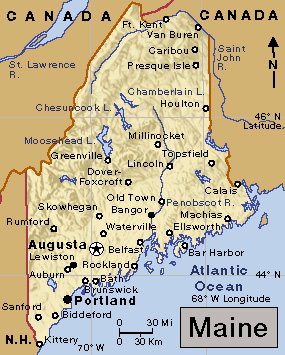
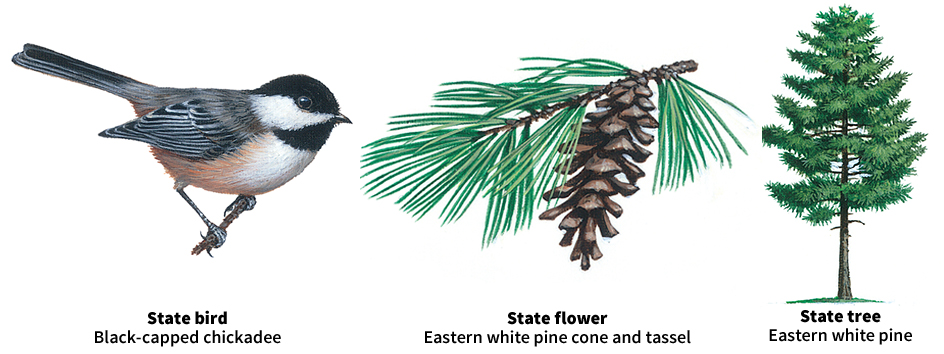
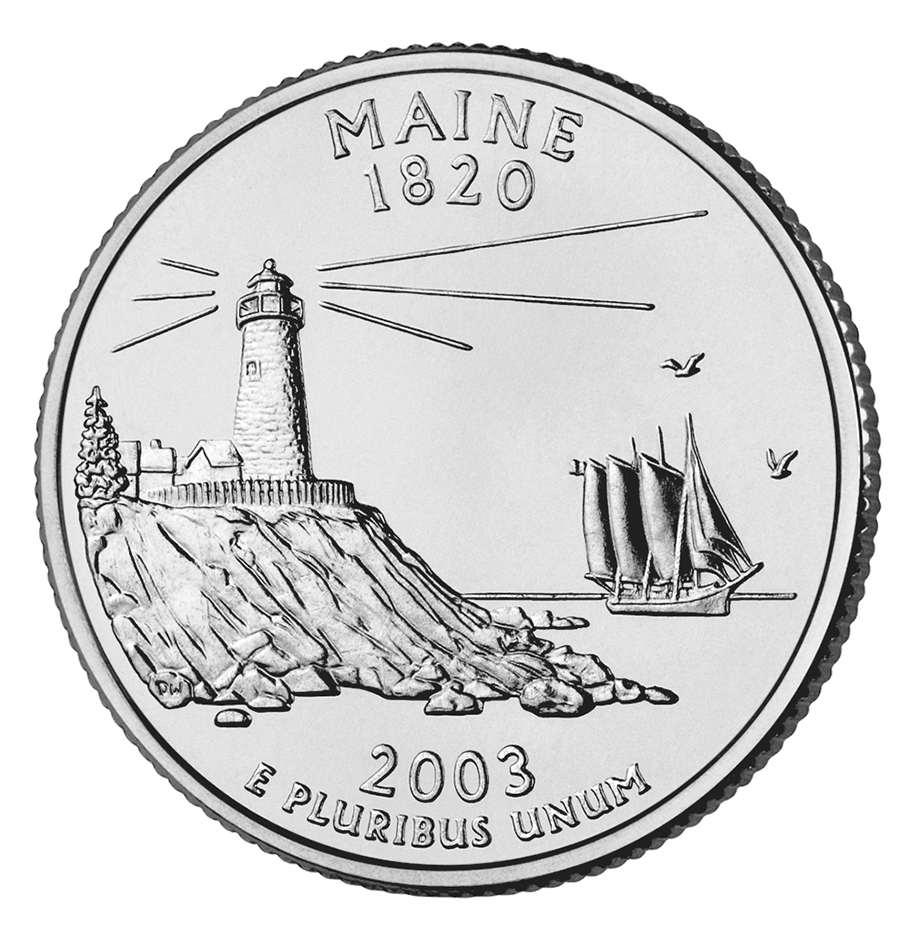
Many towns and cities lie in the lowlands of southern Maine. But forests cover nearly 90 percent of the state. Trees from Maine’s forests provide raw materials for a wood-processing industry that is an important part of Maine’s economy. Mills in Maine make lumber, paper, pulp, and a variety of other wood products. Maine’s nickname, the Pine Tree State, came from the tall pines that once made up much of the state’s forests. In addition to forest products, Maine also produces aerospace equipment, boats, food products, and semiconductors.
Service industries and fishing are also important in Maine. Many people spend their summer vacations in Maine. They provide much income for lodging places, restaurants, and shops in the state. Maine ranks as one of the leading states in the value of fish and shellfish caught. It leads all other states in lobster fishing.
Pioneering English colonists first settled in Maine in 1607, thirteen years before the Pilgrims landed at Plymouth Rock. Such difficulties as cold weather and a lack of leadership forced the settlers back to England in 1608. English colonists, primarily fishermen, made permanent settlements in Maine in the 1620’s. Maine was a part of Massachusetts for about 170 years. Then, on March 15, 1820, it became the 23rd state of the United States.
The name Maine probably means mainland. Early English fishermen used the term The Main to distinguish the mainland from the offshore islands, where they settled. New Englanders often refer to Maine as Down East. They call people who live in Maine Down Easters or Down Easterners. These terms probably come from the location of Maine east of, or downwind from, Boston. Ships from that port sailed down to Maine, and ships from Maine traveled up to Boston.
People
Population.
The 2020 United States census reported that Maine had 1,362,359 people. The population had increased 3 percent over the 2010 figure, 1,328,361. According to the 2020 census, Maine ranks 42nd in population among the 50 states.
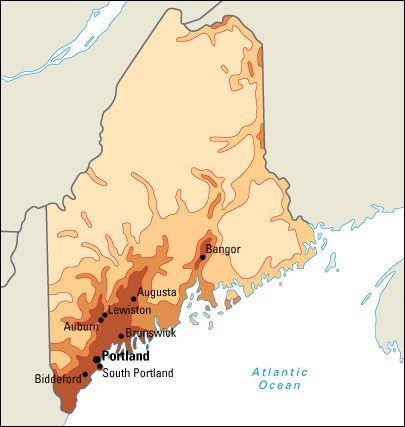
About 40 percent of Maine’s people live in urban areas—that is, in or near municipalities with 5,000 or more people. The state’s largest cities, in order of size, are Portland, Lewiston, Bangor, South Portland, and Auburn.
Three metropolitan areas are entirely within Maine (see Metropolitan area). They are Bangor, Lewiston-Auburn, and Portland-South Portland. About 60 percent of the state’s people live in these three areas. About 40 percent of Maine’s population live in the Portland-South Portland metropolitan area.
About 95 of every 100 people in Maine were born in the United States. Many of those born in other countries came from Canada. Maine’s largest ancestry groups include people of English, French, French-Canadian, German, and Irish, descent.
Schools.
Colonial Maine offered little opportunity for formal education. Parents and local ministers often served as teachers. The first school in Maine may have been an Indian mission—that is, a Christian religious center for the conversion of Indigenous (native) people—founded in 1696 by Sebastian Rasle, a Roman Catholic priest. Maine’s first known school for white children opened in York in 1701. The first schoolhouse was constructed in Berwick in 1719. A school fund was provided by the state’s Legislature in 1828. In 1872, the state established a tax on all property in Maine for public school funding.
The governor of Maine appoints a commissioner of education and State Board of Education to head Maine’s public school system. These appointments are subject to the approval of the state Legislature. Children ages 7 through 16 are required to attend school. For the number of students and teachers in Maine, see Education (table: U.S. students, teachers, and school expenditures).
Libraries.
One of Maine’s earliest libraries was formed in 1751. This collection of books alternated between parish houses in Kittery and York. Maine now has hundreds of public libraries.
The Maine State Library in Augusta and the Maine Historical Society’s John Marshall and Alida Carroll Brown Research Library in Portland own large collections of books about Maine and its history. Two of the state’s largest public libraries are the Bangor Public Library and the Portland Public Library.
Museums.
The Maine State Museum in Augusta features exhibits on the history of the state. The Peary-MacMillan Arctic Museum at Bowdoin College in Brunswick has displays on culture, environment, and exploration in Arctic regions. The Portland Museum of Art owns large collections of fine and decorative arts, including many works by Maine artists. The Abbe Museum in Bar Harbor features Maine’s Native American culture and history. 
Other museums in Maine include the Brick Store Museum in Kennebunk, the Children’s Museum & Theatre of Maine in Portland, the Maine Maritime Museum in Bath, and the Farnsworth Art Museum in Rockland. See also the Places to Visit section of this article.
Visitor’s guide
Maine’s historic sites, amazing scenery, family attractions, and arts and entertainment attract many vacationers yearly. The state’s coastal region is filled with galleries; boutiques; wide, sandy beaches; lively arts and entertainment communities; and magnificent period architecture. Maine is famous for its beautiful peninsulas of rocky coast and quaint fishing villages.
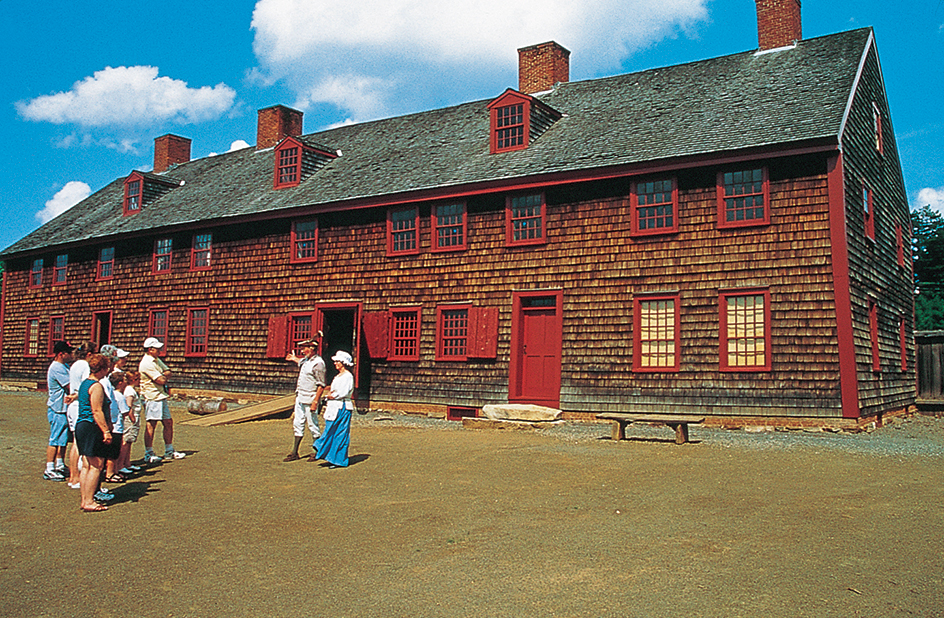
Inland, visitors can enjoy picturesque mountain views, wooded landscapes, historic villages, scenic covered bridges, and old family farms. Fishing enthusiasts can try their luck in one of Maine’s many lakes, ponds, rivers, and streams. During the winter, visitors are drawn to the state’s many ski resorts and snowmobile and cross-country ski trails.
Each season features exciting events taking place throughout the state. Many events are a celebration of Maine’s heritage and culture. Among the state’s outstanding annual events is the Maine Lobster Festival. This celebration is held in Rockland during the first weekend in August.
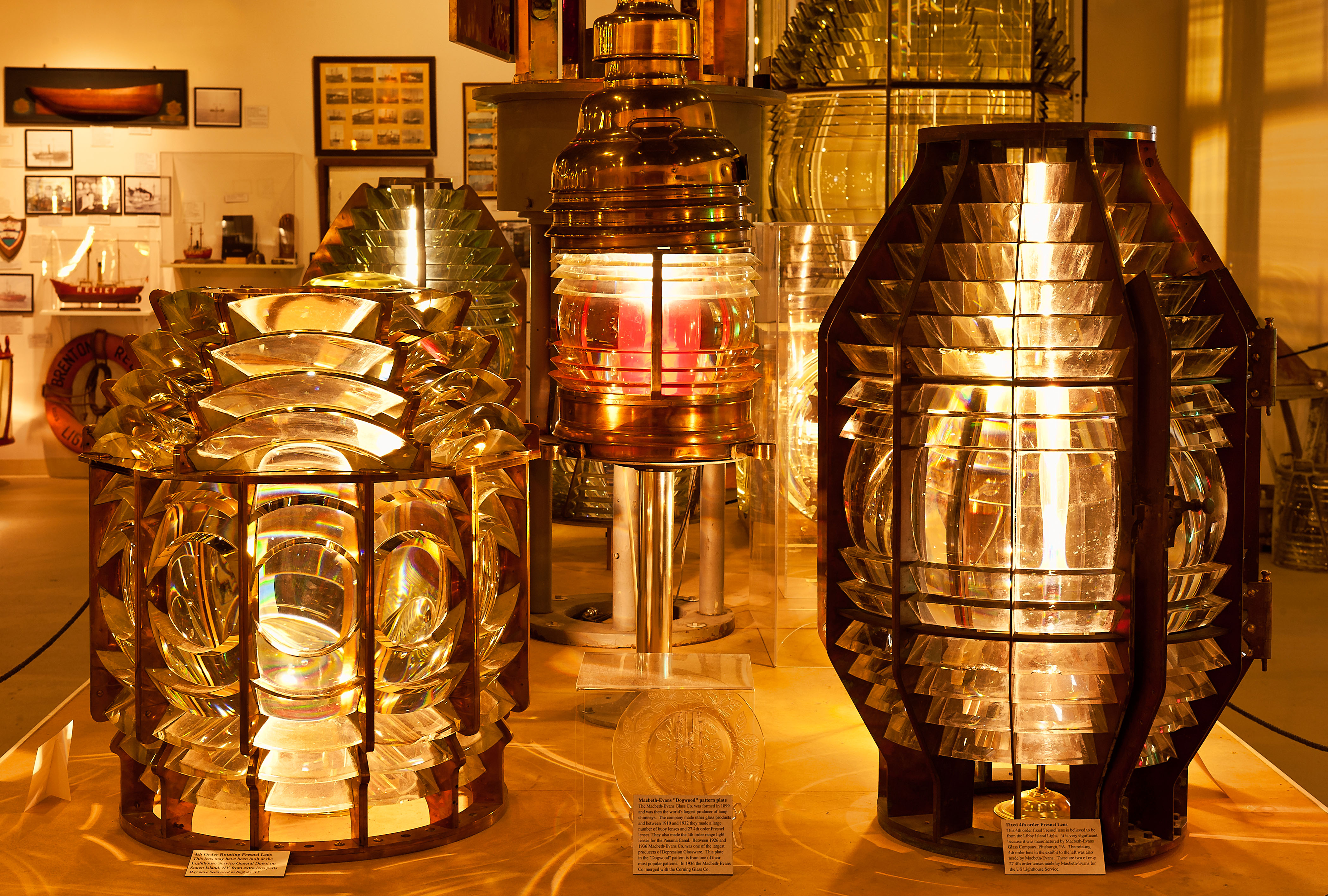
Land and climate
Land regions.
Maine has three natural land regions. They are, from southeast to northwest: (1) the Coastal Lowlands, (2) the Eastern New England Upland, and (3) the White Mountains Region.
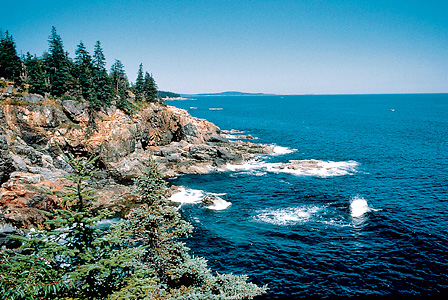
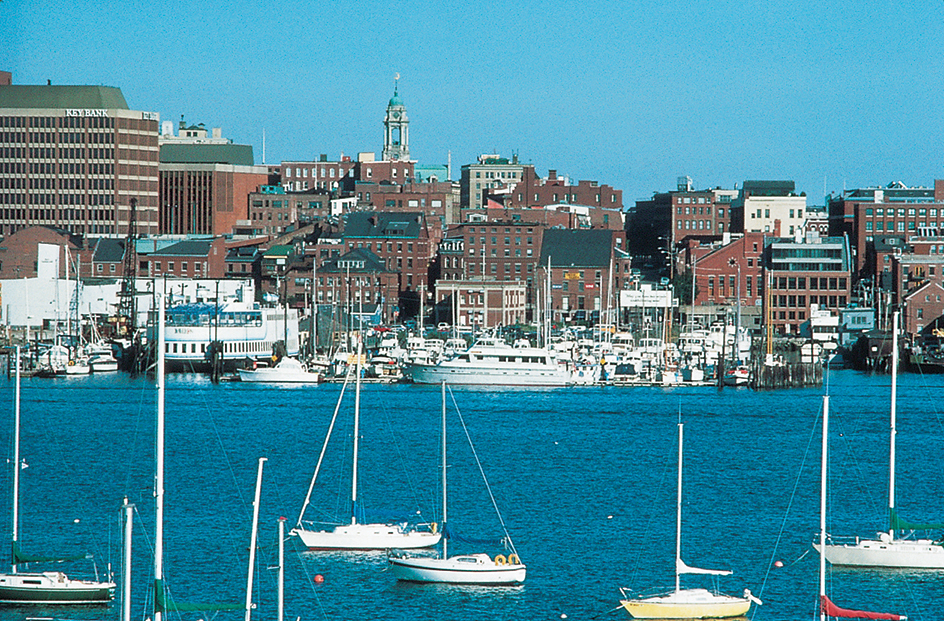

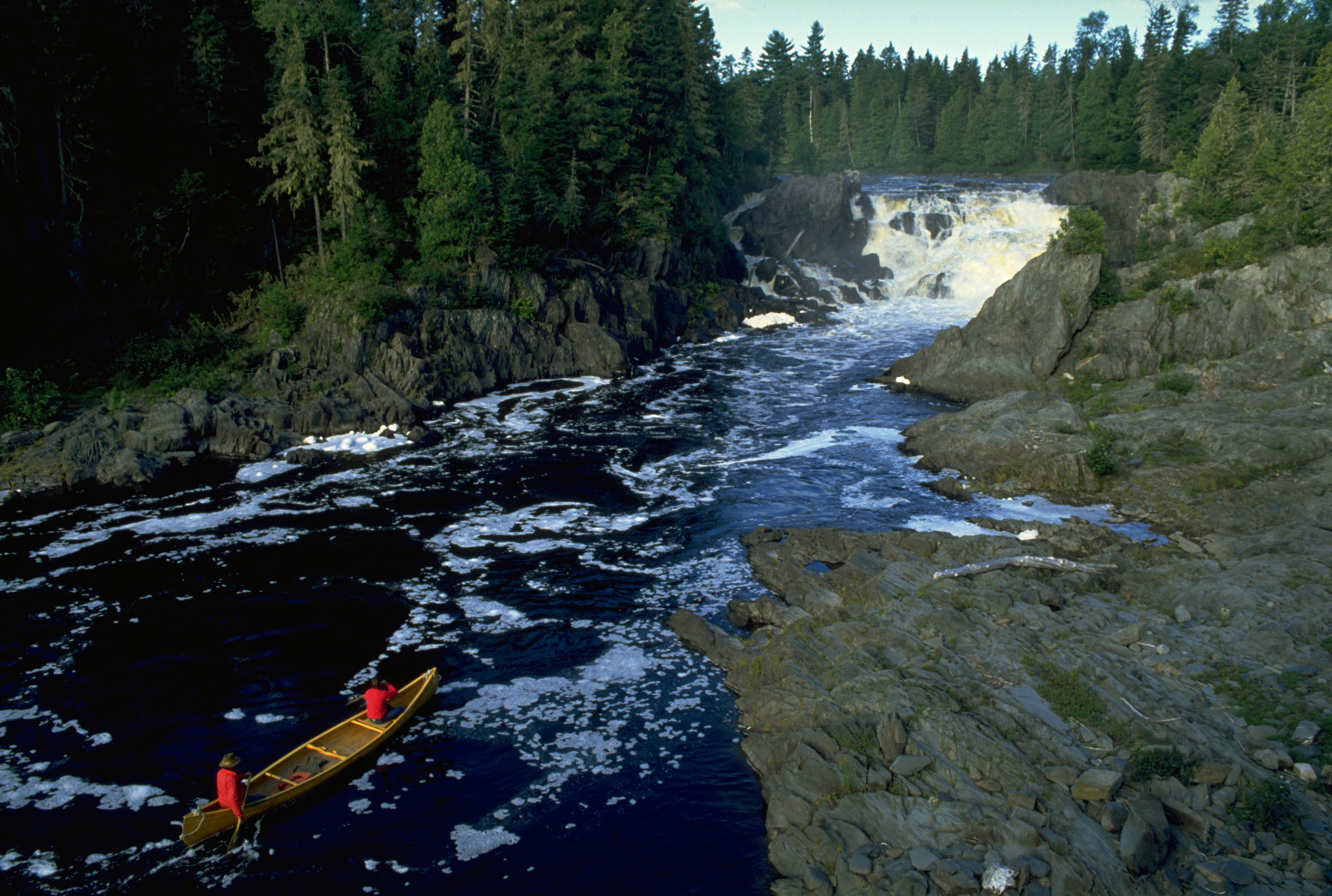

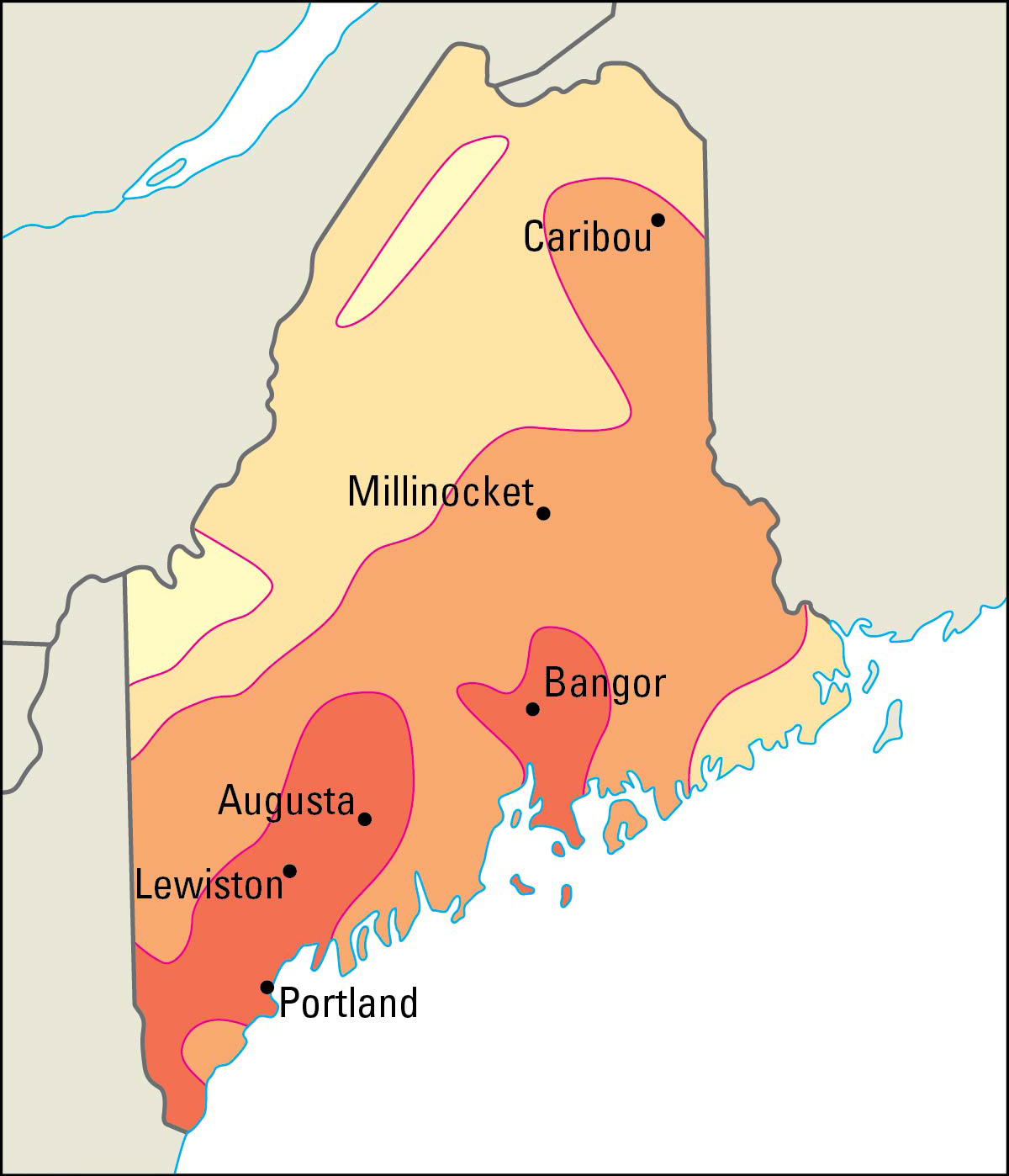
The Coastal Lowlands
cover southeastern Maine. They are part of a region of the same name that stretches along the entire New England coast. In Maine, the region extends from 10 to 40 miles (16 to 64 kilometers) inland from the Atlantic Ocean. Sandy beaches line the coast in the south. Old Orchard Beach, with 11 miles (18 kilometers) of hard-packed sand, is one of the longest and smoothest beaches on the Atlantic Coast. Salt marshes, crossed by tidal creeks, lie west of the beaches. In the northeast, the beaches shrink to small bays or strips of sand between high cliffs.
Most of the Coastal Lowlands lie near sea level. The land was once much higher than it is today. It was pushed down thousands of years ago, during the ice age, which ended about 11,500 years ago, by the weight of ice and snow. The tops of sunken hills form more than 400 offshore islands from about 2 to 25 square miles (5 to 65 square kilometers) in area, and thousands of smaller islands. Mount Desert, the state’s largest island, covers about 100 square miles (260 square kilometers).
The Eastern New England Upland
lies northwest of the Coastal Lowlands. The entire upland extends from the Canadian border to Connecticut. In Maine, the region is from 20 to 50 miles (32 to 80 kilometers) wide. The land rises from elevations near sea level in the east to about 2,000 feet (610 meters) in the west. The Aroostook Plateau lies in the northeasternmost part of the region. Farmers there grow one of the country’s largest potato crops. Many lakes dot the Eastern New England Upland south of the Aroostook Plateau. Swift streams also flow through this area. Most of them are fed by springs and by melted snow. Mountains extend through the center of the region.
The White Mountains Region
covers northwestern Maine and part of New Hampshire and Vermont. In Maine, the region is about 5 miles (8 kilometers) wide in the north and 30 miles (48 kilometers) wide in the south. The White Mountains Region includes hundreds of lakes and most of Maine’s highest mountains. The mountains are an extension of New Hampshire’s White Mountains. See White Mountains.
Coastline
of Maine has many deep harbors and thousands of bays, coves, and inlets. If the state’s coastline is measured in a straight line, it totals 228 miles (367 kilometers). However, if all of the area that is washed by water is measured, the coastline totals 3,478 miles (5,597 kilometers).
Mountains.
Mount Katahdin, Maine’s highest peak, rises 5,267 feet (1,606 meters) in the central part of the state. Nine other mountains are more than 4,000 feet (1,200 meters) high, and 97 others are over 3,000 feet (910 meters) high. Most of the mountains are forested and look green all year long. Cadillac Mountain towers 1,530 feet (466 meters) on Mount Desert Island. It is the highest point on the Atlantic coast between Labrador, Canada, and Rio de Janeiro, Brazil.
Rivers and lakes.
Maine has more than 5,000 rivers and streams. Two of the chief rivers, the Androscoggin and the Saco, begin in New Hampshire. They flow across southern Maine and empty into the Atlantic Ocean. Two other important rivers, the Kennebec and the Penobscot, rise in lakes of north-central Maine. They wind down the center of the state, and empty into coastal bays. The St. Croix River forms the southern part of the border between Maine and New Brunswick. In northern Maine, the Saint John River also is part of the border with New Brunswick. The Saint John is the longest river in the northern part of the state (see Saint John River).
Many of Maine’s more than 2,500 lakes and ponds gleam like blue gems among dark forests. Moosehead, the largest lake, covers about 120 square miles (311 square kilometers) in the west-central part of the state. Other large lakes in Maine include the Belgrades, the Grands, Rangeley, and Sebago.
Plant and animal life.
Forests cover nearly 90 percent of Maine. Valuable trees include the balsam fir, basswood, beech, hemlock, maple, oak, pine, spruce, and white and yellow birch. The speckled alder, a common shrub, thrives in Maine’s swamps and pastures. Witch hazel borders much of the state’s forestland. Chokeberries, shadbush, sumac, and thorn apples grow along country roads and farm fences. Blueberry bushes can be found in much of Hancock and Washington counties and in a few other areas.
Maine’s most common wildflowers are the anemone, aster, bittersweet, black-eyed Susan, buttercup, goldenrod, harebell, hepatica, Indian pipe, orange and red hawkweed, white oxeye daisy, and wild bergamot. Lady’s-slippers and delicate mayflowers are found scattered through many of Maine’s wooded areas. Jack-in-the-pulpit, knotgrass, lavender, and wild lily of the valley grow along the coast and many lakeshores.
Moose are found throughout Maine, particularly in the northern and western parts of the state. Maine is also home to many black bears, particularly northern, western, and central Maine. Other animals found in the state include beavers, bobcats, coyotes, foxes, lynxes, martens, minks, rabbits, raccoons, squirrels, skunks, and white-tailed deer.
More than 320 kinds of birds live in Maine. The most common ones are buntings, chickadees, grackles, owls, sparrows, swallows, thrushes, and wrens. Ducks, gulls, loons, and other sea birds live on the coastal islands in the state.
The game fishes most commonly found in Maine’s lakes and streams are brook trout, landlocked salmon, and smallmouth bass. Other fishes of the inland waters include bass, white and yellow perch, and pickerel. Every spring, many alewives swim up Maine’s coastal rivers to lay their eggs. Then they return to the ocean. Atlantic salmon, once plentiful in Maine, have become threatened due to overfishing, pollution, and dams that block the way to spawning habitats. Efforts are being made to increase the numbers of salmon in the state. Fishes in the state’s coastal waters include cod, flounder, hake, mackerel, pollock, striped bass, and tuna.
Climate.
Maine has cooler weather than most of the rest of the United States. Arctic air and coastal winds from the Labrador Current, a cold ocean current that rises from the Arctic Ocean, keep Maine from being warmed by Gulf Stream air. For this reason, Maine has few hot summer days. See Labrador Current. 
January temperatures average about 10 °F (–12 °C) in northern Maine and about 20 °F (–7 °C) in southern Maine. July temperatures average about 67 °F (19 °C) throughout the state. The state’s record low temperature, –50 °F (–46 °C), was set along the Big Black River near Depot Mountain on Jan. 16, 2009. Maine’s record high temperature, 105 °F (41 °C), was set in North Bridgton on July 4 and 10, 1911.
Maine’s yearly precipitation averages about 42 inches (107 centimeters). The coast of Maine averages less snow than the interior part of the state. The coastal area has much fog.
Economy
Maine’s economy depends heavily on the state’s natural resources. Extensive forests support the state’s important paper and wood products industry. Fine coastal ports provide a base for Maine’s valuable fishing and shipbuilding industries. Farming is important in southern Maine and in Aroostook County. The state’s natural beauty also benefits the important tourist industries. Millions of tourists visit Maine each year, contributing significantly to the state’s economy.
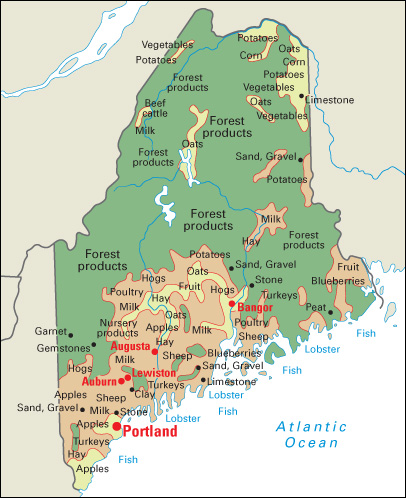
Natural resources
of Maine include forests, fertile soils, and some mineral deposits.
Forests
cover nearly 90 percent of Maine’s total land area—the highest percentage of any state in the nation. The forests supply the raw material for many products manufactured in Maine. Private companies and individuals own nearly all of Maine’s forestland. Until the late 1700’s, the white pine tree was Maine’s greatest resource. The white pine was used mainly to make masts for ships. By the mid-1800’s, the pines had been cut down throughout the state. Today, most of the state’s many pine trees are second-growth trees. Other valuable trees that grow in Maine include ash, aspen, balsam fir, beech, hemlock, maple, oak, spruce, and white and yellow birch.
Soil
in Maine ranges from sand in the western part of the state to heavy loams in the northern regions. Clay soils cover much of Maine’s lowlands. Gravelly soils are common at Maine’s higher elevations. These soils once supported many small family farms. Today, farms are larger, but most are still family-owned.
Minerals.
Southern Maine has many granite and limestone deposits, but few of them are mined. Aroostook County has one of the largest copper and zinc deposits in the United States, but these deposits are difficult to mine. Tourmaline, a gemstone that is Maine’s state mineral, is found in southwestern Maine (see Tourmaline). Slate deposits lie near Brownville and Monson in the central part of the state. Other mined products include brick clay, garnet, peat, portland cement, sand and gravel, and stone. Most of the mines in Maine are on the coast and in the western part of the state.
Service industries,
taken together, account for about four-fifths of both Maine’s employment and its gross domestic product—the total value of all goods and services produced in the state in a year. Most of the state’s service industries are concentrated in metropolitan areas.
Augusta, the state capital, is the center of government activities. The Bangor and Portland areas are Maine’s major centers of banking and insurance. Many of the state’s health care facilities, hotels, and restaurants are also in the Bangor and Portland areas.
The Bangor and Portland areas are the leading centers of Maine’s wholesale and retail trade. Bangor is an important trade and distribution center on the Penobscot River. Portland is one of the chief trading ports on the Atlantic coast.
Manufacturing.
Much of Maine’s manufacturing is dedicated to processing its agricultural and forest products. Paper products, which include cardboard boxes, paper bags, and pulp, as well as paper, are one of Maine’s leading manufactured products. Paper and pulp mills operate throughout the state. Spruce and fir trees provide most of the wood used in Maine’s paper and pulp industries. 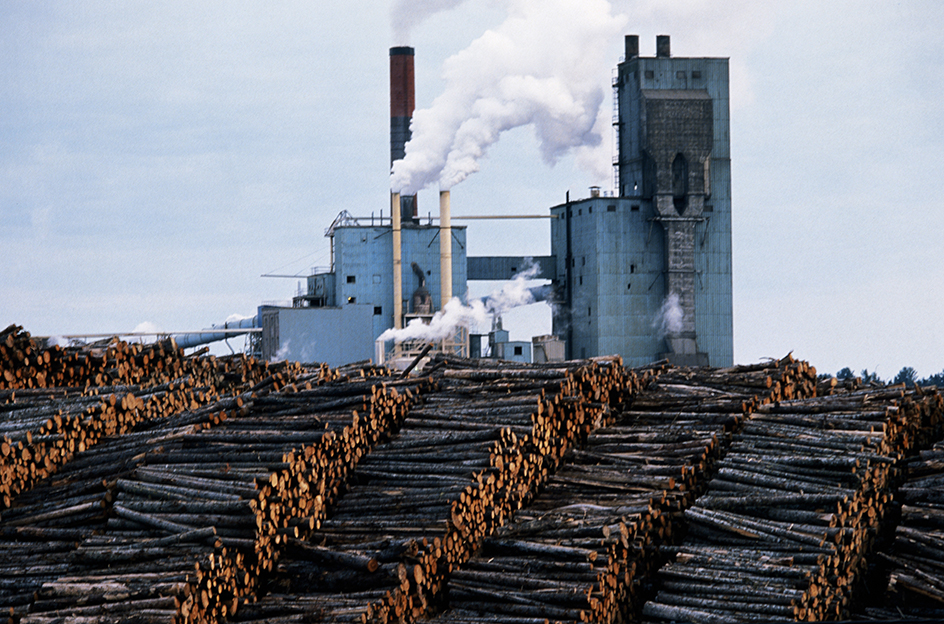
Food and wood products are also important manufactured goods in Maine. Much of the food production is in the southwest corner of the state. Baked goods and frozen foods are the state’s chief food products. Maine canneries produce baked beans, soups and chowders, and other products. Frozen fish and frozen potato products also bring in much income. Sawmills and lumber camps primarily operate in the southwestern part of Maine and in Aroostook County. Lumber is the leading type of wood product. Specialty wood products are also important in Maine. Speciality wood products include clothespins, lobster traps, musical instruments, and wreaths.
The building and repair of ships and boats are important manufacturing activities in the state. Aerospace equipment, computer and electronics products, fabricated metal products, and plastics products are primarily manufactured in the Portland area. Communications equipment and semiconductors are important computer and electronics products manufactured in Maine. Footwear is the most important type of leather product. The L. L. Bean Company of Freeport is famous for its boots and other outdoor wear.
Agriculture.
Farmland covers less than 10 percent of Maine’s land area. Livestock products account for over half of Maine’s agricultural income. Eggs and milk are the leading livestock products. Egg production is greatest in southern Maine. Most of the state’s dairy farms are in Androscoggin, Kennebec, Penobscot, Somerset, and Waldo counties. Livestock raised on Maine farms include beef cattle, chickens, hogs, sheep, and turkeys.
Crops account for less than half of Maine’s farm income. Potatoes are by far the most valuable farm crop. Maine is an important potato-growing state. Most of Maine’s potato crop comes from Aroostook County. Oats are an important field crop in Maine. Many farmers rotate oats and potatoes to keep soil fertile. Much of Maine’s farmland is used to raise crops to feed livestock. Many farmers grow corn, hay, oats, and other grains to feed cattle. Greenhouse and nursery products and dry beans, peas, pumpkins, squash, and other vegetables are also grown in Maine.
Apples are a valuable fruit crop in Maine. They are grown chiefly in the southwestern part of the state. Other Maine fruits include raspberries and strawberries. Maine is a leading producer of wild blueberries and maple products.
Fishing industry.
Maine ranks high among the states in the value of fish and shellfish caught. Its yearly lobster catch is the largest of any state. The state’s fisheries also bring in considerable quantities of soft-shell clams, crabs, eels, mussels, and sea urchins. Maine ranks among the leading states in the size of its cod catch. The fish catch also includes valuable amounts of flounder, hake, pollock, sea herring, and tuna. Fish farms near the coast breed valuable quantities of Atlantic salmon. Portland, Rockland, and Stonington are the chief fishing ports in Maine. Almost every community along the coast has at least a small fleet of fishing boats.
Mining.
Maine’s mining industry is based on the production of cement, crushed stone, and sand and gravel. Portland cement is primarily produced in the southwestern part of the state. Granite and limestone are the most important crushed stone products. Slabs of granite are mined on the southwestern part of Mount Desert Island. Sand and gravel are produced throughout the state.
Maine’s other mined products include clays, gemstones, and peat. Brick manufacturers mine clays in Androscoggin County. Southwestern Maine provides such gemstones as amethyst, garnet, and tourmaline. Washington County in eastern Maine has a large peat bog.
Northern Maine has large copper and zinc deposits. Mining companies have been slow to develop these deposits, however, because they are difficult to mine.
Electric power and utilities.
Most of the state’s electric power comes from wind power, hydroelectric plants, and power plants that burn natural gas, petroleum, or wood waste. The majority of the hydroelectric plants in Maine are on the Androscoggin, Kennebec, Penobscot, and Saco rivers. Maine obtains a higher percentage of its power from renewable sources than most other states.
Transportation.
Maine began developing good roads during the early 1800’s. Today, the state has an extensive system of roads and highways. The Maine Turnpike runs about 110 miles (177 kilometers) between Kittery and Augusta. Interstate Highway 95 extends the turnpike from Augusta to Houlton, near the Canadian border. United States Highway 1 follows the coast of Maine.
Maine’s first railroad was built in 1836 to carry lumber between Bangor and Old Town. Today, rail lines provide freight service in the state. Amtrak provides passenger rail service between Portland and Boston.
Portland International Jetport is Maine’s busiest airport. Bangor International Airport is the closest airport to Europe within the United States.
Large oceangoing vessels can dock at some Maine ports. The state’s busiest docks are at Eastport, Portland, and near Penobscot Bay. Eastport is closer to Europe than any other United States transatlantic port. The Bath Iron Works runs one of the largest dry-dock facilities for ship repair on the East Coast. 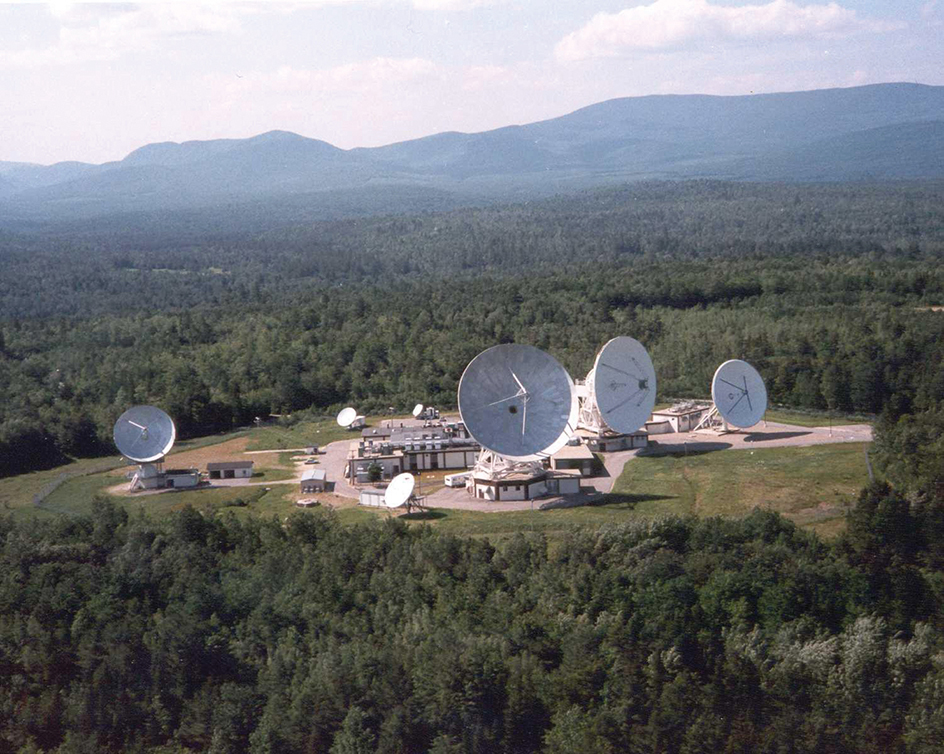
Communication.
Among Maine newspapers, the Portland Press Herald/Maine Sunday Telegram has the largest circulation. Maine’s other major papers include the Bangor Daily News, The (Brunswick) Times Record, the Morning Sentinel in Waterville, the Kennebec Journal in Augusta, and the Lewiston Sun-Journal. The Falmouth Gazette, Maine’s first paper, began in Falmouth (now Portland) in 1785.
Government
Constitution.
Maine is governed under its original constitution. The Constitution was adopted in December 1819, about three months before Maine became a state. Amendments to the Constitution may be proposed by a two-thirds vote in both the Senate and the House of Representatives. To become effective, these amendments need the approval of a majority of the state’s voters in a regular election. In addition, Amendments can be proposed by a constitutional convention. A two-thirds vote of both houses of the Legislature is needed to call a constitutional convention. Maine has never held such a convention.
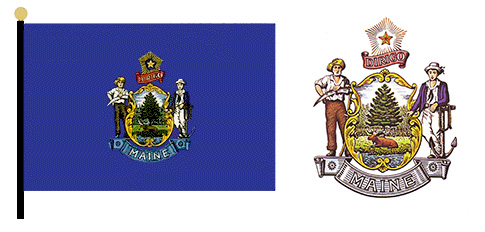
Executive.
The governor is the only Maine executive official elected by the people. The governor serves a four-year term. The governor may serve any number of terms but not more than two in succession. Maine has no lieutenant governor. The Legislature elects the attorney general, secretary of state, and state treasurer to two-year terms. These officials are limited to serving four terms in a row. The Legislature also elects the state auditor to a four-year term. The auditor is limited to serving two terms in succession.
Legislature
of Maine consists of a 35-member Senate and a 151-member House of Representatives. Each of the state’s 35 senatorial districts elects one senator. Maine has 151 representative districts, each of which elects one representative. The House also reserves 3 seats for representatives of the Penobscot Nation, the Passamaquoddy Tribe, and the Houlton Band of Maliseet Indians. These Native American representatives can speak in the legislature but cannot vote. Senators and representatives are elected to two-year terms in even-numbered years. They are limited to serving four terms in a row. 

Maine’s Senate and House of Representatives hold two legislative sessions. The first session begins on the first Wednesday of December following the election. It may last until the third Wednesday in June. The second session begins on the Wednesday following the first Tuesday of January of the next even-numbered year. It may last until the third Wednesday in April. Either session may be extended twice for up to five days by a two-thirds vote of the legislature.
Courts.
The Supreme Judicial Court is Maine’s highest court of appeals for all civil and criminal cases. The court has a chief justice and six associate justices. Maine’s Superior Court handles all cases requiring trial by jury and all cases appealed from lower courts. Each of Maine’s counties has one Superior Court, except for Aroostook County, which has two. Justices on the Supreme Judicial and Superior courts serve seven-year terms.
Maine’s District Courts are divided among the state’s 13 districts. The District Courts hear cases involving civil and minor criminal cases. District Court judges serve seven-year terms.
The justices of the Supreme Judicial Court, the Superior Courts, and the District Courts are appointed by the governor with the approval of two-thirds of the Senate. Each county in Maine has a probate court, whose judges are elected by the people to four-year terms.
Local government.
Each of Maine’s 23 cities has home rule. That is, each city may adopt or revise a charter without approval of the Legislature. Most cities in the state have a council-manager form of government.
Maine has about 470 towns and plantations (small incorporated areas). Most towns consist of several communities governed together as a unit. The town meeting is the most common form of government in Maine towns. It allows citizens to take a direct part in government. Each year, voters assemble to elect officials, approve budgets, and do other business. Other towns hire a manager to oversee daily operations.
The chief town officials are called selectmen. Maine’s plantations are each governed by a board of assessors. Maine also has hundreds of townships that have no organized government. In addition, the state has three self-governing Indian townships, each headed by a governor, a lieutenant governor, and a tribal council. Each of Maine’s 16 counties has its own government.
Revenue.
Taxation provides about half of the state government’s general revenue (income). Most of the rest comes from federal grants and other U.S. government programs. A personal income tax and a general sales tax together account for about two-thirds of the state tax revenue. Other important sources of tax revenue include taxes on alcoholic beverages, corporate income, motor fuels, motor vehicle licenses, property, and tobacco products. The property tax is a primary source of income for Maine’s public school districts. Maine’s other sources of general revenue include government services and a state lottery.
Politics.
Maine was a Democratic state before the 1850’s. But most Maine voters became Republicans in the period shortly before the American Civil War. They favored the Republican Party’s antislavery and pro-Northern policies. For about a hundred years, until the 1950’s, Maine voters almost always elected Republicans in state, congressional, and presidential elections. The Republicans are still a strong party in Maine. But since the 1960’s, the Democrats have achieved a better balance of power with the Republicans. For example, the Democrats have often controlled the state legislature.
From 1856 until 1964, Maine voted for the Republican candidate in every presidential election but one. In 1912, the state supported Democrat Woodrow Wilson. Since the 1960’s, however, Republican and Democratic candidates have won about the same number of times. For years, Maine held its elections for Congress and governor in September. Its voters often chose candidates from the party that later won November elections in other states. This led to the slogan, “As Maine goes, so goes the nation.” In 1960, Maine began voting in November.
In 1969, Maine’s legislature passed a law that established the congressional district method to distribute the state’s electoral votes. The method gives one electoral vote to each of Maine’s congressional districts. Two other electoral votes, to represent the state’s two senators, go to the winner statewide. Maine first split its electoral votes in 2016, when the Republican candidate, Donald J. Trump, won one of Maine’s four electors.
History
Early days.
Thousands of Indigenous people lived in what is now Maine before European settlers came. The people belonged to the Abenaki and Etchemin tribes of the Algonquian family. The Abenaki lived west of the Penobscot River, and the Etchemin lived east of the river. The Algonquian people had villages but often moved in search of food. Their enemy, the Iroquois, frequently raided their villages.
Exploration and settlements.
France sent many explorers to North America. These explorers included Giovanni da Verrazzano, who arrived in 1524, and Samuel de Champlain and Pierre du Gua (or du Guast), Sieur de Monts, who reached Maine in 1604. Champlain explored and named Mount Desert, the largest island along Maine’s coast. 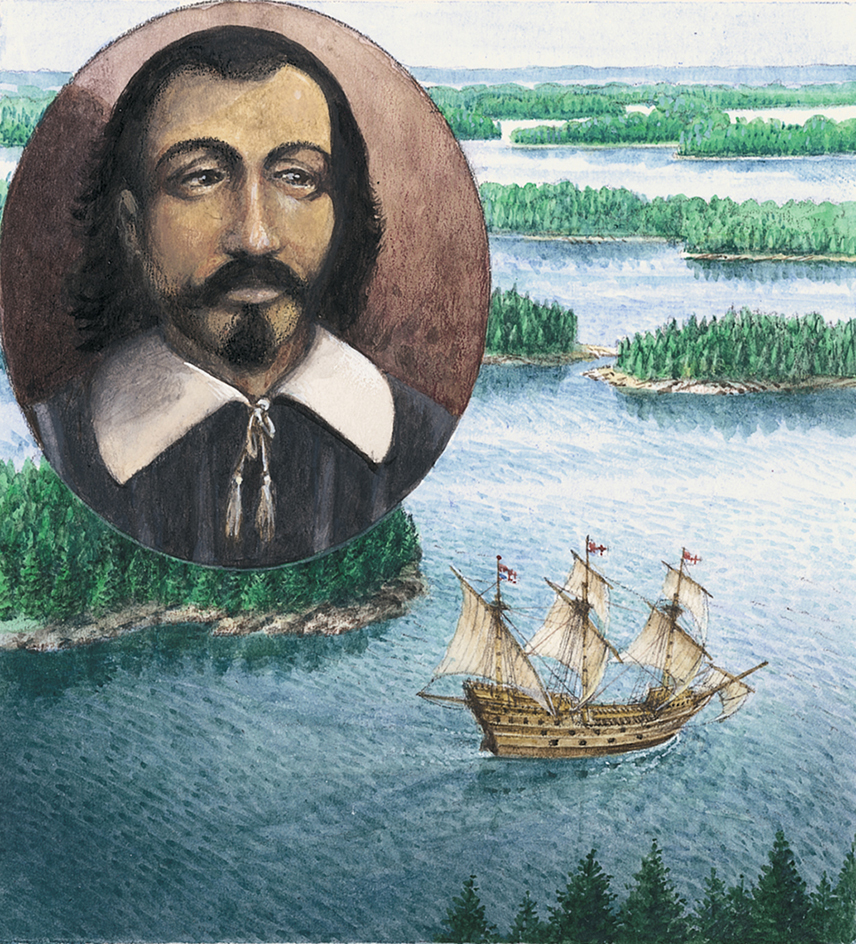
In 1605, two wealthy Englishmen, Sir Ferdinando Gorges and Lord Chief Justice of England Sir John Popham, sent George Waymouth to explore the Maine coast. Waymouth’s favorable reports about the area led Gorges and Popham to attempt a settlement in Maine. In 1607, they financed a group of colonists who established the Popham Colony, near the mouth of the Kennebec River. Such difficulties as a cold winter, troubles with Indigenous people, and the death of George Popham, Sir John’s nephew and the leader of the group, forced the settlers to return to England in 1608. While in Maine, the settlers built a boat called the Virginia. It was the first boat built by English colonists in America.
The English made many permanent settlements in Maine during the early 1620’s. Perhaps the first one was the settlement made near present-day Saco in 1623.
Ownership disputes
developed over Maine during the 1600’s. In 1622, the Council for New England, an agency of the English government, gave Ferdinando Gorges and John Mason a large tract of land in present-day Maine and New Hampshire. The land was divided between the two men in 1629, and Gorges received the Maine section. Gorges established Maine’s first government in 1636. In 1641, he made the community of Gorgeana (now York) a city. It was the first chartered English city in what is now the United States.
After Gorges died in 1647, the people of Kittery, Wells, and York united under a new government. Between 1652 and 1658, they and the people of Casco Bay, Kennebunk, Saco, and Scarborough agreed to make Maine a part of the Massachusetts Bay Colony. In 1660, the heirs of Gorges disputed Massachusetts’s ownership of Maine, and claimed Maine for themselves. In 1664, an English board of commissioners ordered Maine restored to the Gorges family. Massachusetts finally gained clear title to Maine in 1677, when it bought the area from the Gorges family.
Indian wars
—that is, conflicts between Indigenous groups and European settlers—were fought in Maine and the rest of New England off and on from 1675 to 1763. In 1675, fighting broke out in the Plymouth Colony between the Wampanoag and some colonists and flared up quickly in other parts of New England. The conflict became known as King Philip’s War after the Wampanoag leader Metacom, whom the colonists called King Philip. The fighting ended in southern New England in 1676 but continued in northern New England until 1678.
A series of conflicts called the French and Indian wars began in 1689 and ended in 1763. The French and their Indigenous allies battled to gain control of the area from the English colonists. William Pepperrell of Maine led the capture of the French fortress of Louisbourg, Nova Scotia, in 1745. The capture was one of the major events of the conflict. The French and Indian wars ended with the Treaty of Paris in 1763, which gave the British most of France’s territory in North America.
The Revolutionary War.
During the 1760’s, the United Kingdom passed a series of laws that caused unrest in Maine and the rest of colonial America. Most of these laws either imposed severe taxes or restricted colonial trade. In 1774, a group of Maine patriots burned a supply of British tea stored at York. This event, called the York Tea Party, resembled the more famous Boston Tea Party of 1773.
The Revolutionary War (1775-1783) started at Lexington and Concord, Massachusetts. Hundreds of Maine patriots joined the fight for independence. The war brought great hardships to Maine towns. In 1775, British troops burned Falmouth (now Portland) to punish the townspeople for opposing the king’s policies.
The first naval battle of the Revolutionary War was fought off Machias in June 1775. In the battle, a group of Maine patriots captured the British ship Margaretta. Also in 1775, Benedict Arnold and his troops made a long march from Augusta to Quebec. They tried to capture Quebec from the British but were pushed back. British troops occupied Castine in 1779. Colonial troops and ships tried to recapture the town but were badly defeated.
Maine’s population increased greatly after the war. Massachusetts rewarded its soldiers with gifts of land in Maine and sold Maine land to other people.
In the early 1800’s, Maine’s economy depended on its pine forests. Wood from the forests was used to build ships and many other products. The Embargo Act of 1807, which limited U.S. trade with other countries, hurt Maine’s thriving shipping industry. But the slowdown in shipping forced Maine to seek new income by developing its manufacturing industries.
Statehood.
In 1785, a movement began for the separation of Maine from Massachusetts and for Maine’s admission to the Union. Many people in Maine protested heavy taxation, poor roads, the long distance to the capital city of Boston, and other conditions. But before the War of 1812, most voters wanted Maine to remain a part of Massachusetts. The separation movement grew much stronger after the war. Many of those who favored separation won election to the Legislature. They swayed many voters to their side. The people voted for separation in 1819, and Maine entered the Union as the 23rd state on March 15, 1820. William King became the first state governor, and Portland was the first capital of Maine. Augusta became the capital in 1832. 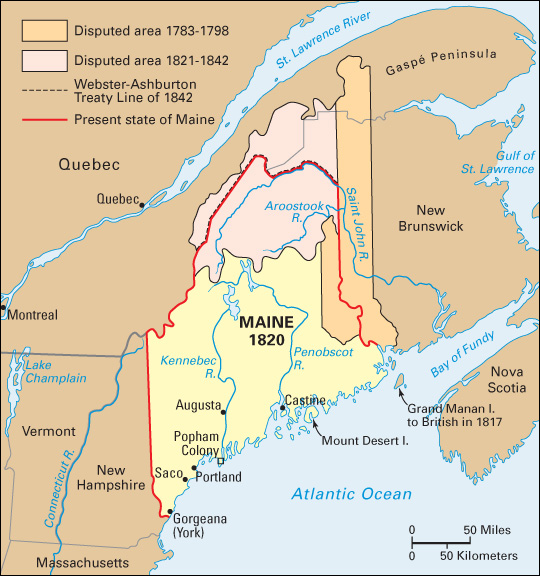
Maine’s admission to the Union became involved in the Missouri Compromise. The compromise called for Maine to enter the Union as a free state (a state without enslaved people) and Missouri to enter the Union as a slave state (a state that permitted slavery). This arrangement kept the number of slave and free states equal. See Missouri Compromise.
Ever since 1783, the boundary between Maine and New Brunswick, Canada, had been disputed. The argument led to the so-called Aroostook War of 1839. The U.S. government sent General Winfield Scott to Maine, and he reached a temporary agreement with Canadian officials. No fighting took place. The boundary was finally set by the Webster-Ashburton Treaty of 1842. See Webster-Ashburton Treaty. 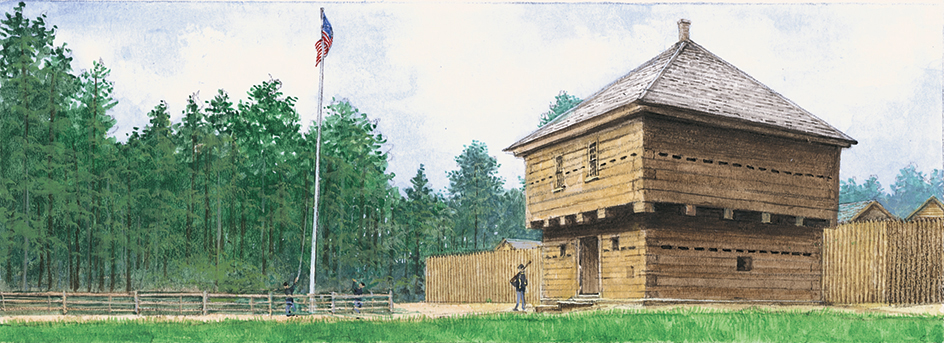
In 1846, Maine became the first state to pass a law prohibiting the manufacture and sale of alcoholic beverages. But the law did not provide for effective enforcement. In 1851, the state passed a new law that banned the production and sale of alcoholic beverages. This law remained in force until 1934.
Antislavery feelings grew strong in Maine during the early 1830’s. The state’s Baptists and Congregationalists opposed slavery especially strongly. About 72,000 Maine men served with the Union forces during the American Civil War (1861-1865). During the war, Hannibal Hamlin, a former U.S. senator and governor of Maine, served as vice president of the United States under President Abraham Lincoln.
Industrial development
increased greatly after the Civil War. The textile and leather industries were among those that grew at record rates. Farming activity and rural populations decreased as industry grew. During the 1890’s, Maine began developing hydroelectric power on its rivers. Businesses competed for the best power sites, and the state legislature acted to protect the state’s power interests. In 1909, the legislature outlawed the sale of hydroelectric power outside the state to keep the power in Maine and attract new industries. The law remained in force until 1955.
The early 1900’s.
In 1907, Maine adopted an initiative and referendum law (see Initiative and referendum). The state adopted a direct primary voting law in 1911. This law gives Maine voters a voice in choosing candidates for state elections.
The number of small farms in Maine continued to decrease during the 1920’s. Many large farms were started, especially in Aroostook County. These farms specialized in potato growing and in dairy and poultry products. Industrial growth also continued during the 1920’s. However, some Maine textile mills moved to the South because of lower costs there. The state made up its loss with a greatly expanded paper and pulp industry. The Great Depression of the 1930’s slowed Maine’s economy. But conditions improved as the depression eased in the late 1930’s.
The mid-1900’s.
Margaret Chase Smith, a Maine Republican, won fame during the 1940’s. She became the first woman elected to both houses of the U.S. Congress. Smith served in the House of Representatives from 1940 to 1949 and in the Senate from 1949 to 1973. See Smith, Margaret Chase.
During World War II (1939-1945), Maine mills and factories produced military shoes and uniforms. Shipyards in Bath and South Portland built cargo and combat vessels. After the war, the state legislature passed laws to encourage industry to come to Maine. These laws included reduced tax rates for new businesses. The highway system was expanded, and many motels were built to accommodate Maine’s growing tourist trade.
During the 1950’s, Maine’s economy was helped by the construction of Air Force bases. Small-scale farming all but ended in Maine, and some of the state’s oldest textile mills closed. Many small electronics companies were established in the state during this period.
The state Department of Economic Development, established in 1955, and various community development groups helped bring new industries to Maine during the 1960’s. Paper and pulp companies expanded, and Maine’s food-processing industry also grew. Improved skiing facilities attracted thousands of winter tourists to the state.
The Democratic Party gained strength during the 1950’s and 1960’s. In 1955, Edmund S. Muskie became Maine’s first Democratic governor since 1937. In 1958, he became the first Democrat ever elected to the United States Senate by Maine voters. President Lyndon B. Johnson won Maine’s electoral votes in 1964—the first time Maine voted for a Democratic presidential candidate in more than 50 years. Muskie was the Democratic vice presidential candidate in 1968, but he and Hubert H. Humphrey lost to their Republican opponents, Richard M. Nixon and Spiro T. Agnew. Muskie later served as secretary of state under President Jimmy Carter. In 1969, the Maine legislature approved state personal and corporate income taxes for the first time.
The late 1900’s.
In 1980, the United States government agreed to pay $811/2 million to the Passamaquoddy, Penobscot, and Maliseet (also called Wolastoqiyik) tribes of Maine. The money was payment for Indigenous lands seized through false and illegal treaties during the late 1700’s and early 1800’s.
Maine benefited from efforts by environmentalists to clean up the state’s rivers and harbors. Laws they sponsored forced paper companies and municipalities to improve procedures to dispose of industrial and other wastes. Maine’s waterways became cleaner, and attempts to set up oil refineries at various coastal sites were defeated. Beginning in the late 1900’s and continuing into the 2000’s, some river dams were removed that prevented fish from reaching spawning areas.
Maine’s economic development was uneven in the late 1900’s. The pulp and paper industry expanded rapidly at the start of the period, but increased automation later eliminated many jobs. Maine’s valuable fir and spruce forests were overharvested and damaged by insects. A fishing boom led to overfishing. The resulting lower fish catch and foreign competition harmed Maine’s fishing industry. Foreign competition also reduced employment in the state’s shoe manufacturing industry.
Maine’s economic problems occurred mainly in the northern and central parts of the state. Mainers in the southwestern area found jobs in shipbuilding and electronics and in new service industries. Coastal and ski areas profited from expanded tourism in the 1980’s and 1990’s.
The state’s only nuclear power plant, Maine Yankee, closed in 1997. The plant, operating since 1972, had become too costly to run, and it needed extensive repairs.
The early 2000’s.
In 2000, the Legislature passed a bill designed to lower prescription drug prices in the state. Maine became the first state in the nation to adopt such legislation. The pharmaceutical industry challenged the law in court. But a ruling by the U.S. Supreme Court in 2003 allowed the state to proceed with putting the program, called Maine Rx, into effect.
Also in 2003, the Legislature passed a health insurance plan to make low-cost coverage available to state residents by 2009. The legislation calls for the creation of a semiprivate agency that will help residents get medical coverage through private insurers.
In August 2016, President Barack Obama designated about 87,500 acres (35,400 hectares) of land in north-central Maine as Katahdin Woods and Waters National Monument. A foundation started by entrepreneur Roxanne Quimby had donated the land to the U.S. Department of the Interior, which oversees the National Park Service. The monument protects mountainous forestland and offers views of Mount Katahdin, which stands in adjacent Baxter State Park. The designation of the national monument came despite political opposition. Earlier in the year, Maine’s legislature narrowly passed, and Governor Paul LePage signed, a largely symbolic bill opposing a new federal park in the state.
A deadly mass shooting occurred in southern Maine in late October 2023. A gunman shot dozens of people, killing 18, at a bowling alley and a bar in Lewiston. Hundreds of local, state, and federal law enforcement officers joined in a manhunt for the shooter. The body of the suspect was found two days after the shooting. Officials said he had died from a self-inflicted gunshot wound.
